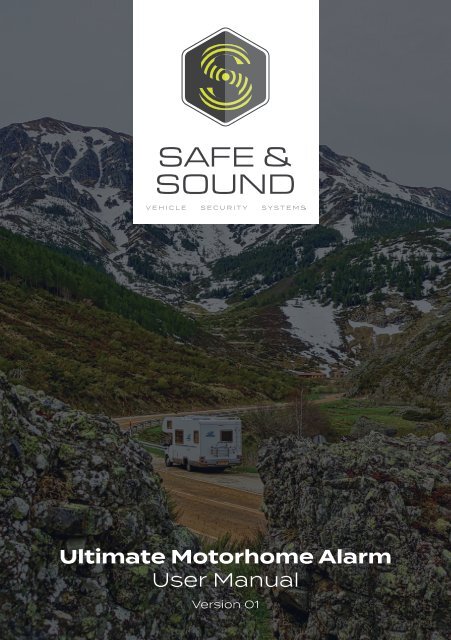Ultimate Motorhome Alarm - User Manual version 01
The Ultimate Motorhome Alarm by Safe & Sound Vehicle Systems is designed to meet and exceed the expectations of the modern leisure vehicle owner by presenting the system to you with additional, high-quality sensors and parts, in a format not readily available anywhere else in the industry.
The Ultimate Motorhome Alarm by Safe & Sound Vehicle Systems is designed to meet and exceed the expectations of the modern leisure vehicle owner by presenting the system to you with additional, high-quality sensors and parts, in a format not readily available anywhere else in the industry.
Create successful ePaper yourself
Turn your PDF publications into a flip-book with our unique Google optimized e-Paper software.
<strong>Ultimate</strong> <strong>Motorhome</strong> <strong>Alarm</strong><br />
<strong>User</strong> <strong>Manual</strong><br />
Version <strong>01</strong>
TABLE OF CONENTS<br />
<strong>User</strong> <strong>Manual</strong> - Version <strong>01</strong><br />
1.0 Introductory Note<br />
2.0 Operating Procedure<br />
2.1 Complete system arming<br />
2.2 Night Mode - System arming with sensor exclusion<br />
2.3 Arming delay<br />
2.4 System armed<br />
2.5 System disarming<br />
2.6 <strong>Alarm</strong>, Inhibit time between <strong>Alarm</strong>s and <strong>Alarm</strong> cycles<br />
2.7 Tracking System Monitoring of <strong>Alarm</strong> Sounding<br />
2.8 Passive arming<br />
2.9 Emergency disarm by electronic key<br />
2.10 Locker Door Sensors<br />
2.11 Internal Passive Infrared Sensors (PIR)<br />
3.0 <strong>Alarm</strong> Memory<br />
4.0 Technical Specifications
1.0 Introductory Note<br />
Dear Customer,<br />
Thank you for purchasing our <strong>Ultimate</strong> <strong>Motorhome</strong> <strong>Alarm</strong>.<br />
Based on the incredible Sigma SIGS37 alarm system, the<br />
<strong>Ultimate</strong> <strong>Motorhome</strong> <strong>Alarm</strong> by Safe & Sound Vehicle Systems<br />
is designed to meet and exceed the expectations of<br />
the modern leisure vehicle owner by presenting the system<br />
to you with additional, high quality sensors and parts, in a<br />
format not readily available anywhere else in the industry.<br />
Please read the present manual carefully to familiarise<br />
yourself fully with the alarm system features and operating<br />
procedures and do keep it handy for future reference.<br />
Many Thanks<br />
Mark Ingham<br />
Managing Director<br />
Safe & Sound
2.0 Operating Procedure<br />
2.1 Complete System Arming<br />
Press the lock button on the vehicle original remote control or button 1 on the<br />
optional Sigma remote control; arming is confirmed by a beep and a flash<br />
of the turn indicators (if features are enabled). The system has a 30” arming<br />
delay during which the LED is ON steady.<br />
2.2 Night Mode - Arming With Sensor Exclusion<br />
The system can be armed without activating internal volumetric protection<br />
(wireless infrared or wireless hyper frequency and dash mounted ultrasonic<br />
sensors) while keeping perimeter protection. This is done in one of two ways,<br />
A) with the vehicles remote control or B) with the additional Sigma remote<br />
control.<br />
Proceed as follows:<br />
Method A – Using the vehicles remote control<br />
• Make sure the system is disarmed and ignition key is “OFF”.<br />
• Touch the electronic key to its receptacle*; the LED will give a quick flash.<br />
• Close vehicle doors and press the lock button on the vehicle original remote<br />
control*.<br />
• System activation is confirmed by a beep and a flash of the turn indicators<br />
(if features are enabled).<br />
Method B – Using The Sigma Remote Control<br />
• Ensure the ignition is off<br />
• Simply press button 3<br />
• System activation is confirmed by a beep and a flash of the turn indicators<br />
(if features are enabled).<br />
Please note – Where night mode is required it should be activated on each<br />
arming of the alarm.<br />
Example: Activating Night Mode to go to bed, then disarming the alarm one<br />
hour later to let your dog out to the toilet would require Night Mode activating<br />
before returning to bed.
2.3 Arming Delay<br />
After the system is armed, there is a 30” delay time (LED ON steady)<br />
2.4 System Armed<br />
After the delay time the system is armed and ready to detect any alarm condition.<br />
The LED will start flashing when the system is fully armed.<br />
2.5 System Disarming<br />
The system can be disarmed by pressing the unlock button of the vehicles<br />
remote control or button 2 of the optional Sigma remote control (where supplied).<br />
Five beeps and five flashes of the turn indicators, when the system is<br />
disarmed (if features are enabled), warn there has been an alarm condition<br />
prior to disarming. <strong>Alarm</strong> causes and relative LED signals are listed in par. 3.0<br />
2.6 <strong>Alarm</strong>, Inhibit Time Between <strong>Alarm</strong>s And <strong>Alarm</strong> Cycles<br />
<strong>Alarm</strong> Conditions are signalled by optical signals and audible, battery backup<br />
siren. Once the alarm ceases, there is a 5” time-interval before another alarm<br />
goes off. Each alarm event generates up to ten 30-second alarm cycles for<br />
each input and for each arm cycle. During an alarm event, the system can be<br />
disarmed via the remote controls.<br />
2.7 Tracking System Monitoring Of <strong>Alarm</strong> Sounding<br />
Optional Feature. On activation of an alarm trigger you will receive a phone<br />
call/text message from your tracking systems control room. Limited to one<br />
alert every 60 minutes.<br />
2.8 Passive Arming<br />
If passive arming mode is configured, the system automatically arms approx.<br />
60” after ignition is switched OFF and after the last door is opened and closed.<br />
A beep and a flash of the turn indicators will confirm the armed state (if features<br />
are enabled).<br />
Passive Arming is not suitable for leisure vehicles. This feature is disabled<br />
on your <strong>Ultimate</strong> <strong>Motorhome</strong> <strong>Alarm</strong>.
2.9 Emergency Disarming By Electronic Key<br />
This disarm mode is used for “EMERGENCY DISARMING” (in case remote<br />
control is lost or inoperative) and “TOTAL DISARMING”. Touching the electronic<br />
key to its receptable disarms and switches off the system which will not<br />
subsequently rearm via remote control.<br />
To restore normal operation, touch electronic key to its receptacle.<br />
A high-pitched beep and a flash of the status LED will confirm that the system<br />
is back to normal mode.<br />
2.10 Locker Door Sensors<br />
Where supplied, these sensors are uniquely coded to the alarm system and<br />
operate via a wireless connection, powered by a single CR2032 battery contained<br />
within the sensor body. On opening of a protected door, the LED on the<br />
sensor will flash. We recommend changing the batteries within sensors once<br />
every 12 months.<br />
2.11 Internal Passive Infrared Sensor (PIR)<br />
Where supplied, these sensors are uniquely coded to the alarm system and<br />
operate via a wireless connection, powered by two CR2032 battery contained<br />
within the sensor body. Under normal operation, no light or flashes will be<br />
emitted from the sensor. On arming of the alarm system, the sensor will not<br />
detect movement for five minutes after the time it last saw movement. This<br />
conserves the battery power and prevents rapid drain while using the vehicle<br />
under everyday circumstances.<br />
We recommend changing the batteries within sensors once every 12 months.<br />
3.0 <strong>Alarm</strong> Memory<br />
Five beeps and five flashes of the turn indicators upon disarming (if features<br />
are enabled) warn that the alarm has been triggered in your absence. To<br />
identify the last cause of alarm, turn ignition key “ON” and count the number<br />
of flashes of the status LED; they will indicate the last alarm detected. Optical<br />
signals are repeated 3 times in a row; to interrupt, turn ignition key “OFF”.
The table below lists the various alarm causes and relative number of LED<br />
flashes.<br />
4.0 Technical Specification<br />
Arm<br />
Disarm<br />
Arm in Night/<br />
Pet mode/PANIC<br />
Not used<br />
Sigma<br />
Notes: Panic can be activated with a long press of button 3 and only available when the alarm its armed state.
Leeds Head Office<br />
<strong>01</strong>13 3979597<br />
sales@sasmobile.co.uk<br />
www.sasmobile.co.uk

















